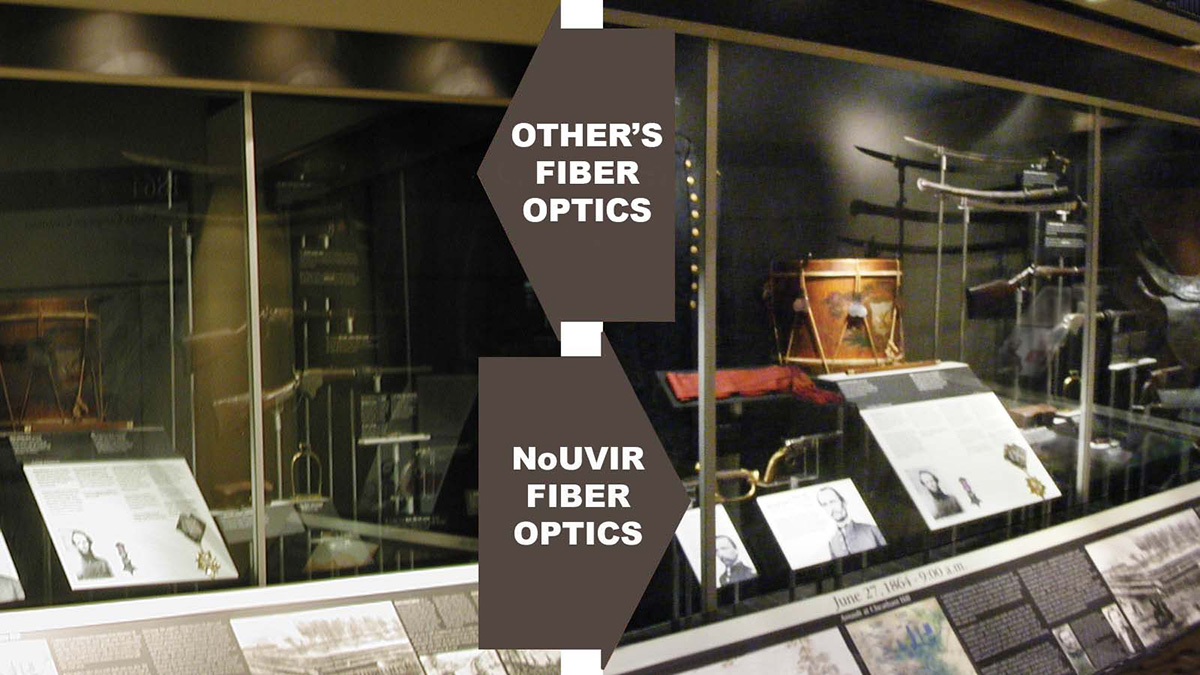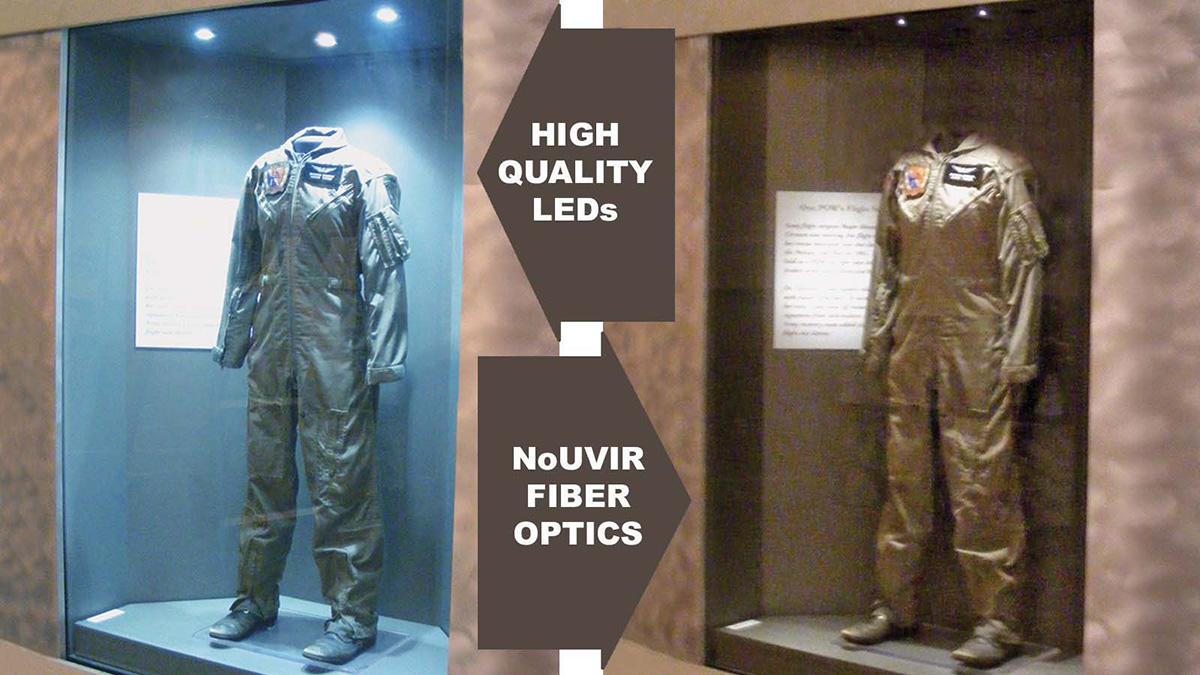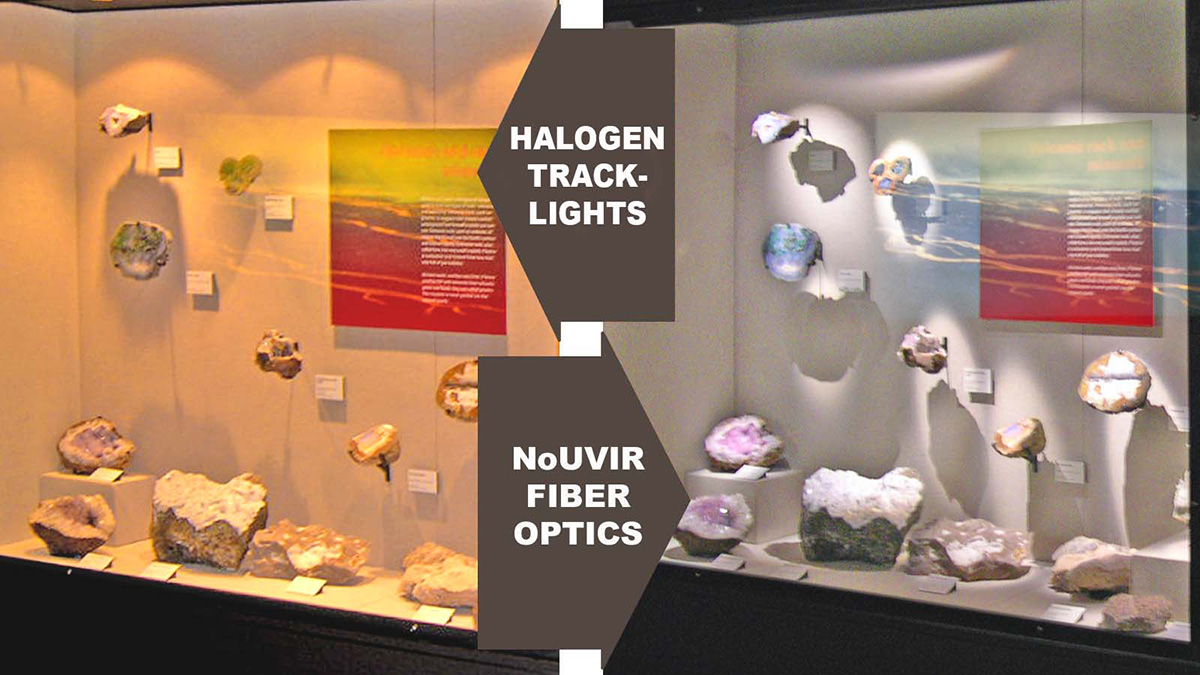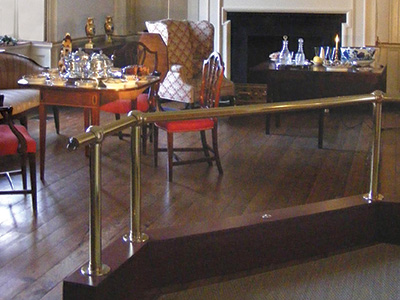" Pure-white, stone-cold fiber optic lighting sytems "
Expert Manufacturer
Excellent Products, Expert Help,
Over 25 Years of Manufacturing in the USA
Compare Fiber Optic Systems Head-to-Head

 Compare THREE to FOUR TIMES the projectors, fiber and lights producing a very different result
in what visitors see even though the museum conservation footcandle limits are identical. Relit with NoUVIR, the cases showed the
artifacts instead of hid them in gray light.
Compare THREE to FOUR TIMES the projectors, fiber and lights producing a very different result
in what visitors see even though the museum conservation footcandle limits are identical. Relit with NoUVIR, the cases showed the
artifacts instead of hid them in gray light.
To add insult to injury, NoUVIR systems less hardware added up to enough extra to light the outside text rails with fiber optics.
Can you find the rare Civil War military saddle? The museum staff lost the artifact too. It’s in the righthand corner of the case (right edge of both images).
These results are typical. Others have to use 2x, 3x, 4x up to 8x the hardware to get “equivalent” footcandles with lackluster presentation,
because other fiber optic companies beams are poor in quality. This need for a lot more product also means there is a large costing gap between competitors and NoUVIR.
Less expensive competitors cost a lot more. Why? You have to buy, install and maintain a lot more hardware. You have to change more lamps.
Probably the best way of comparing fiber optic systems head-to-head is to read what people say.
Compare LEDs Head-to-Head
The best white LEDs are not really white. An LED is a “blue pump phosphor lamp”. A blue pump phosphor lamp is the lighting industry’s technical name for all LED sources. The color you see may “look” white, but what you really see is blue color shifted to white. The LEDs blue bias was really obvious in this case, because the uniform was olive with no pattern.

The color problem in a side-by-side comparison is obvious. In practice, the poor color rendition wasn’t really noticed.
The visitors simply walked past the case. The color made the uniform boring.
But the biggest problem was the LEDs glare. It is distracting. It drowns out the uniform.
Notice how the LEDs overly wash the cases’s walls.
The walls are brighter than the artifact.
Notice the bright mini-suns in the case’s ceiling. Ugly. Unappealing.
The sign is the brightest object, so bright that the words disappear in a photograph from over exposure.
The uniform desperately needed NoUVIR’s control, so the uniform was lit and the walls were not.
This case was added to an installation.
No planning. Just a request to please fix the “ugly case” in the next room by re-arrange the fiber optic lighting design in the other galleries.
The change was dramatic. A few fibers were run from a projector in the gallery next door, through the wall into the case.
See the advantage of buying fiber in rolls and being able to cut and polish it in the field?
Notice more than the color difference. See how muted the case’s background has become. It no longer dominates.
And what about the glare? It’s gone. The tiny fiber optic lights at the top of the case are nearly invisible. No more bright spots screaming for attention above the uniform.
Compare Halogen Lighting Head-to-Head
The human eye has a hard time determining true white. The brain corrects to white. In practice this case looked white when lit with the halogen track lights in the case’s attic. The staff was frustrated, because of the scalloped shadows at the top of the case and the fact that the specimens on the case’s floor were lit at 1/4th the light level of the objects on the wall.

Side-by-side the color difference becomes obvious. But look at the specimens on the case’s floor.
Light spreads and “falls off” at 1/r squared But NoUVIR lets you zoom to tighter beams for reach.
So spots could be aimed past the wall to the floor of the case as smaller, brighter beams. No fall off.
The specimens at the top of the case and the bottom of the case are at the same lighting levels.
Again, look at the specimens. Look how they’ve become more awesomely beautiful.
The curator of this case wanted the gemstones framed in light.
He made this exhibit dramatic. But the most exciting aspects was that the geodes displayed more vivid colors.
It’s presentation.
Why light minerals, gemstones and cut gems with fiber optic lighting? It is not as if lighting will cause the “rocks” to fade. These are rocks.
But you might be surprised. Several semiprecious gemstones and minerals fissure, crack and spall thermally under long-term exposure to light.
Relit this case has no heat.
Turn the lights on in the morning, the geodes’ surfaces will not warm before their interiors.
The internal stresses inside the rocks has stopped.
Turn the lights off at night and the geodes’ surfaces cool before the rocks’ warm cores cool.
The gemstones are stressed again.
That thermal expansion and contraction day in and day out eventually cracks, breaks and create spalling as dust around the minerals and gemstones.
NoUVIR stops this photomechanical damage.
Compare Halogen and LED Lighting Head-to-Head
Halogen lights are 92% to 94% heat. LED lights are 72% to 78% heat.
That is IR. There is a big different in the heat wattage. But LEDs still have IR.
Just notice the heat sinks and fins, the internally mounted fans behind the circuit boards and that if mounted in a case, the case’s temperature will go up.
NoUVIR has no IR. There is no heat. And that is why fiber optic lighting was used for this luxury wine cellar.
This is not cooking wine. And neither are the lights cooking the wine.

Fine wines add up in value. Even very fine wines that are modest in price can be greater than the value of an art collection in a mansion as each bottle increases the overall asset total.
All of the lighting in this space is NoUVIR fiber optics.
The chandelier is fiber optic lighting. The wall sconces are fiber optic.
Only NoUVIR lights these wines. (Lighting expert Read Hunker, Light Notes Inc., did this space and is credited for the photo.)
LEDs improve the IR problem compared to halogen lamps. There is less heat. But LEDs still have an effect on objects.
A study showed that consumers preferred the taste of milk at its expiration date over fresh milk with a good expiration date lit by just 4 hours under LEDs in a grocery store case.
Hint? Buy your milk from the back of the stack where it is in shadow.
Did you get that? If there is a taste difference in milk, there is probably a taste difference in wine.
This is a fact fine collectors and real wine aficionados need to consider. Have your lights robbed your taste buds?
Compare Lighting a Historic Room Head-to-Head
Make a fiber optic bannister as a piece of furniture. Set in place. Remove at any time.

That’s right. Portable light that is a bannister. Can any other type of lighting illuminate a room with so little in construction? NoUVIR can be very low impact.
Spots contained inside the portable bannister’s rail light the room.
And electrical cord from the base of the bannister plugs into a grounded wall outlet.
Set in place. Adjust the lights and you are lit. But you can get fancier.
This colonial house museum pulled a few fibers out of the bannister, ran them under a rug and added lit candles on the table among the early American china.
A crystal argand light (an artifact) was also lit at a side table.
In the photo you can see the lights in the bannister as the photograph is taken across the table.
But visitors just see a room light by candles and whale oil lamps.
Several historic house museums have installed their own fiber optic lighting.
 One director had wives from Germany taking a week-long seminar on cataloging.
The museum did not know what to do with the husbands.
She handed an engineering-type the NoUVIR instructions and said,
“Try this out? If nothing else, you can unpack the hardware.” The new recruits did her whole installation.
She said, “They had a great time. I think they had more fun than the girls.”
One director had wives from Germany taking a week-long seminar on cataloging.
The museum did not know what to do with the husbands.
She handed an engineering-type the NoUVIR instructions and said,
“Try this out? If nothing else, you can unpack the hardware.” The new recruits did her whole installation.
She said, “They had a great time. I think they had more fun than the girls.”
Another house museum was asked about cutting and polishing fiber.
The director laughed.
“We have these wonderful senior ladies that are docents.
They handle the front desk. We cut the fiber, handed it to them (with polishing buff) and we would get this perfectly polished fiber back while they gossiped.
They were so proud they helped with the installation, they can hardly wait for the next one.”